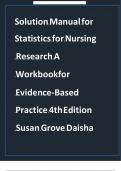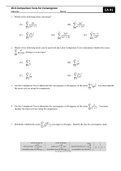Solution Manual for
b b
Statistics for Nursing
b b
ib Research A b
b Workbookfor b
b Evidence-Based
b Practice 4th Edition
b i
ib Susan Grove Daisha
b b
, AnsweribGuidelinesibforibQuestionsibto bBe iGraded
EXER iCISE
Identifying Levels ib i
ofMeasurement: Nominal,
b ii b
Ordinal, Interval, and
ib ib i
ib
ib i i
1
Ratio bi
The i questions i are i in i bold i followed i by i answers.
1. In iTable i1, iidentify ithe i ilevel i iof i imeasurement i ifor i ithe i icurrent i itherapy i ivariable.
iProvide i a i rationale i for i your i answer.
Answer: iThe icurrent itherapy ivariable iwas imeasured iat ithe inominal ilevel. i iThese i idrug
icategories iwere iprobably ideveloped ito ibe iexhaustive ifor ithis istudy i iand i iincluded i ithe
icategories iof idrugs i ithe i isubjects i iwere i ireceiving. i iHowever, i ithe i icategories i iare i inot
iexclusive, isince i ipatients i iare i iusually i ion i imore i ithan i ione i icategory i iof i ithese i idrugs i
ito imanage itheir i ihealth i iproblems. i iThe i icurrent i itherapies i iare i inot i imeasured i iat i ithe i
iordinal ilevel ibecause ithey icannot i ibe i irank i iordered, i isince i ino i idrug i icategory i ican i ibe i
iconsidered imore ior iless i ibeneficial i ithan i ianother i idrug i icategory i i(see i iFigure i i1-1; i
iGrove i i& i iGray, i2019).
2. What i is i the i mode i for i the i current i therapy i variable i in i this i study? i Provide
i airationale i for iyour i answer.
Answer: i The i mode i for i current i therapy i was i β i blocker. i A i total i of i 100 i (94%) i of
i the i cardiacipatients
were i i receiving i i this i i category i i of i i drug, i i which i i i was i i i the i i i most i i i common i i
i prescribedidrug i for i this isample.
3. What i statistics i were i conducted i to i describe i i the i i BMI i i of i i the i i cardiac i
i patients i i in ithis isample? iDiscuss iwhether ithese ianalysis itechniques iwere iappropriate
ior iinappropriate.
Answer: i BMI i was i described i i iwith i i ia i i imean i i iand i i istandard i i ideviation i i i(SD). i i iBMI
imeasurement i resulted i in i ratio-level i data i with i continuous i values i and i i ian i i iabsolute i i
izero i(Stone i & i Frazier, i 2017). i i iRatio- i i ilevel i data i should i be i analyzed i with
i parametric i statistics isuch i as i the i mean i and i SD i (Grove i & i Gray, i2017; i Knapp, i 2017).
4. Researchers i used i the i following i item i to i measure i registered i nurses’ i (RNs)
i income i inia i study: iWhat i category i identifies i your i current i income i as i an i RN?
a. Less i than i $50,000
b. $50,000 i to i 59,999
c. $60,000 i to i 69,999
d. $70,000 i to i 80,000
e. $80,000 i or i greater
What i level i of i measurement i is i this i income i variable? i Does i the i i income i
i variableifollow i the i rules i outlined i in i Figure i 1-1? i Provide i a i rationale i for i your
i answer.
Answer: i In i this i example, i the i income i variable i is i measured i at i the i ordinal i level.
i Theiincome i catego- i ries i are i exhaustive, i ranging i from i less i than i $50,000 i to i greater
i than
$80,000. i The i two i open-ended
,AG i 1-1
, AG i 1-2 Answer i Guidelines i for i Questions i to i Be i Graded
categories iensure ithat iall isalary ilevels iare icovered. iThe icategories iare inot iexclusive, isince
icatego- i ries i (d) i and i (e) i include i an i $80,000 i salary, i so i study i participants i making
$80,000 i imight i imark i ieither i i(d) i i ior i i i(e) i i ior i i iboth i i icategories, i i iresulting i i iin i i
ierroneous idata. iCategory i(e) icould ibe ichanged ito igreater ithan i i$80,000, i imaking i ithe i
icategories iexclusive. iThe icategories ican i ibe i irank i iordered i ifrom i ithe i ilowest i isalary i ito
i ithe i ihighest isalary, i iwhich i iis i iconsistent i iwith i iordinal i idata i i(Grove i i i& i i iGray, i
i2019; i iWaltz i iet i ial., i2017).
5. What ilevel iof imeasurement iis ithe iCDS iscore? iProvide ia irationale ifor iyour ianswer.
iAnswer: i The i CDS i score i is i at i the i i interval i i level i i of i i measurement. i i The i i CDS i i is
i i a i i 26- iitem i iLikert i iscale i ideveloped i ito i imeasure i idepression i iin i i icardiac i i ipatients. i i
iStudy iparticipants i irated i itheir i isymp- i itoms i ion i ia i iscale i iof i i1 i ito i i7, i iwith i i ihigher i i
inumbers iindicating iincreased i iseverity i iin i ithe i idepression i isymptoms. i iThe i itotal i iscores i
ifor i ieach isubject i iobtained i ifrom i ithis i i imulti-item i i iscale i i iare i iconsidered i i ito i ibe i iat i
ithe i iinterval i ilevel iof i measurement i (Gray iet ial., i 2017; i Waltz i et i al., i 2017).
6. Were i nonparametric i or i parametric i analysis i techniques i used i to i analyze i the i i
i CDSiscores ifor ithe icardiac i patients i in i this i study? i Provide i a i rationale i for i your
i answer. iAnswer: i i iParametric i i istatistics, i such i as mean and SD, were
conducted to describeiCDS scores i for i study
i participants i (see i Table i 1). i CDS i scores i are i interval-level i data i as iindicated i in i Questions
i 5, i so i parametric i statistics i are i appropriate i for i this i level i of i data
(Gray i et i al., i 2017; i Kim i & i Mallory, i 2017).
7. Is ithe iprevalence iof idepression ilinked ito ithe iNYHA iclass? i iDiscuss i ithe i iclinical
iimportance i of i this i result.
Answer: i The i study i narrative i indicated i i ithat i i ithe i i iprevalence i i iof i i idepression i i
iincreased i i iwith ithe i greater i NYHA i class. i In i NYHA i class i III, i 64% i i iof i i ithe i i
isubjects i i iwere i i idepressed, iwhereas i11% iof ithe isubjects iwere idepressed iin iNYHA iclass iI.
iThus, ias i the i NYHA i class iincreased, ithe inumber iof isub- ijects iwith idepression iincreased.
i This i is i an i expected i finding ibecause i as i the i NYHA i class i increases, i cardiac
i patients i have i more i i isevere i i iphysical isymptoms, i i iwhich i i iusually i result i in i emotional i
i idistress, i i isuch i i ias i i idepression. i i iNurses i i ineed ito i actively i assess i cardiac i patients i i
ifor i i idepression, i i iespecially i i ithose iin i i ihigher i i iNYHA iclasses, i so i they i might i be
i diagnosed i and i treated i as i needed.
8. What i ifrequency i iand i ipercent i iof i icardiac i ipatients i iin i ithis i istudy i iwere i inot i
ibeing itreated i with i an i i antidepressant? i i Show i i your i i calculations i i and i i round i
i your i i answerito i the i nearest i whole i percent i (%).
Answer: i i A i i total of 106 cardiac patients participated in this
study. The isample included i 15 i patients i who i were i receiving i i an i
i antidepressant i i (see i i Table i i 1).iThe number of cardiac i patients inot
itreated ifor i depression i was i 91 i (106 i – i 15
= i i91). i i iThe i i igroup i i ipercent i i iis i i icalculated i iby i i ithe i i ifollowing i i iformula: i i
i(group ifrequency i i i÷ i itotal i i isample i i isize) i i i× i i100%. i i iFor i i ithis i i istudy, i(91 i
ipatients i i÷ i i106 isample isize) i× i i100% i i= i i0.858 i i× i i100% i i= i i85.8% i i= i i86%. i
iThe i ifinal ianswer i iis irounded i i ito i i ithe i i inearest i i iwhole i i ipercent i i ias i i idirected i i iin i i
ithe i i iquestion. i i i iYou i i icould ihave ialso isubtracted ithe i14% iof ipatients itreated iwith
iantidepressants i ifrom i i100% i iand iobtained i the i 86% i who i were i not i treated i with i an
i antidepressant.
9. What i was i the i purpose i i of i i the i i 6-minute i i walk i i test i i (6MWT)? i i Would i i the
i i 6MWTibe i useful i in i clinical i practice?
Answer: i i iHa i i iet i i ial. i i i(2018) i i istated, i i i―The i i i6-min i i iwalk i i itest i i i(6MWT) i i iis i i ia i i
imeasure i i iof i i ithe isubmaximal, isteady-state i functional i capacity‖ i of i cardiac i patients. i This
i test i would i be i i aiquick, i ieasy i iway i ito i i determine i i a i icardiac i i patient’s i i ifunctional i i





